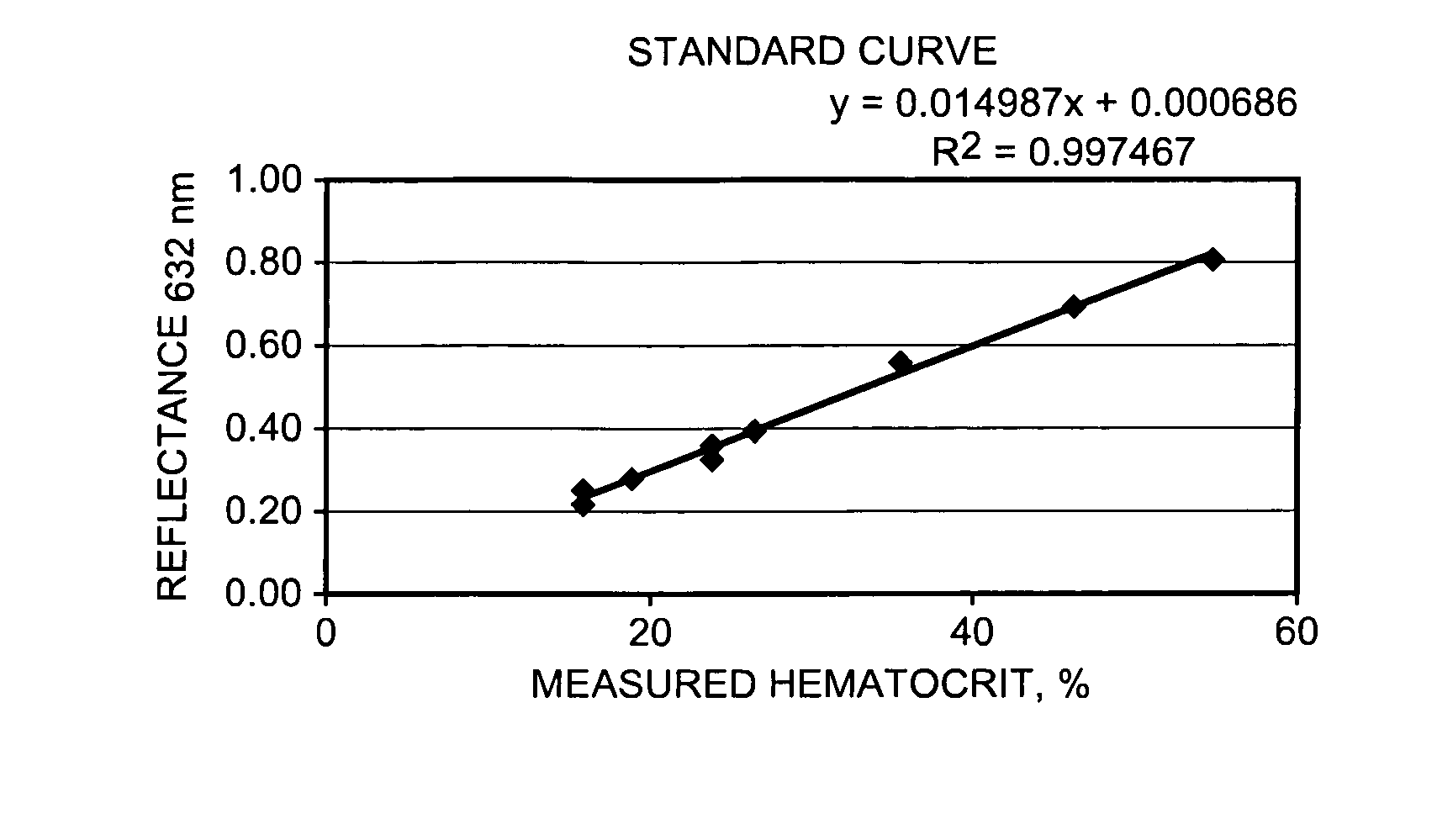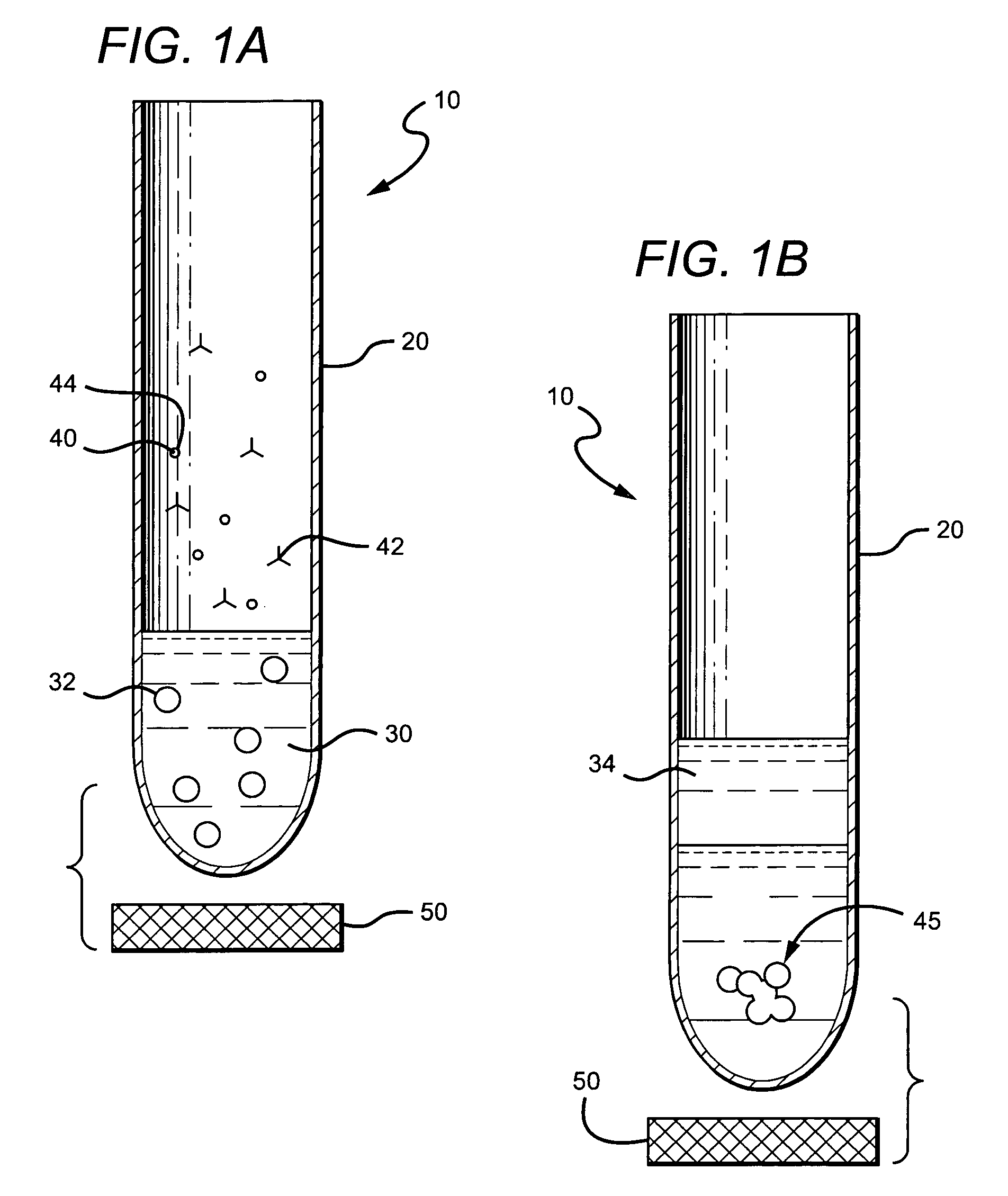Diagnostic device and method
a diagnostic device and a technology for biotechnology, applied in the field of clinical diagnostics and biotechnology, can solve the problems of inability to perform diagnostics using blood-containing samples, inability to perform diagnostics, and inability to meet the needs of patients,
- Summary
- Abstract
- Description
- Claims
- Application Information
AI Technical Summary
Benefits of technology
Problems solved by technology
Method used
Image
Examples
experiment set 1
[0102
[0103]In a first series of experiments, precipitation of red blood cells was performed using mouse anti-red blood cell antibodies, paramagnetic beads coated with goat anti-mouse antibodies and 0.5 ml of anti-coagulated whole blood. Heparinized, EDTA or citrated whole blood was mixed with 10 μl undiluted mouse anti-red blood cell antibody solution (Red Out™; Robbins Scientific Corp.) for 2 minutes; next 10 μl of a solution (isotonic PBS, pH 7.4) containing paramagnetic beads (Cortex Biochem Inc., MagaCell™ or MagaBeads™; 30 mg / mL; or Pierce MagnaBind™) coated with goat anti-mouse antibodies was added and mixed gently for 2 minutes. The bottom of the tube was placed on a magnet (permanent iron magnet; approximately 0.2 Tesla). Precipitation of the cellular network started instantly, and was substantially finished after about 2 minutes. Plasma was collected by aspiration from the top of the vessel.
[0104]Significantly, methods and apparatus described herein have been found to separ...
experiment set 2
[0106
[0107]In a second series of experiments, precipitation of red blood cells on a microscope slide was performed using whole blood, mouse anti-red blood cell antibodies and paramagnetic beads coated with goat anti-mouse antibodies. To 0.2 ml fresh whole blood, 5:1 of an anti-red blood cell antibody containing solution (Red Out™) was added, mixed and incubated for 2 min at room temperature. Then, 5:L of a solution containing paramagnetic beads coated with goat anti-mouse antibodies (MagaCell™ or MagaBeads™ or MagaBind™) was added, mixed, and after another 2 minutes, two disk magnets were positioned at opposite ends of the slide. After about 1.5 minutes, a clear plasma containing zone was formed between the two magnets and this was retrieved with a pipette without disturbing the laterally-fixed cell-containing network.
experiment set 3
[0108
[0109]Flat envelopes sealed on three of four sides were prepared from transparency acetate sheets (for example, the 3M Inc. product, 3MCG3460), or plastic sheet protectors (e.g., Avery-Dennison PV119E), or from small “ZipLock” or ITW Inc. MiniGrip™ bags (2.5×3 cm; 2.0 mil). One-half to 1 mL of anti-coagulated whole blood was injected into the bag; 10 uL of Red Out™ (see above) was added and mixed with blood by gently rocking the container. After 2 minutes, the anti-mouse coated magnetic beads (MagaCell™) were added, mixed and the open side of the bag sealed. Two minutes later the bag was placed horizontally on a rectangular permanent iron magnet (approximately 0.2 Tesla). The magnetic particles and attached cellular networked moved adjacent to the magnet, leaving a clear layer of plasma as supernatant. The bag was then rotated into an upright position while still on the magnet, opened, and plasma aspirated using a pipette. It was also discovered that envelopes or bags (containi...
PUM
| Property | Measurement | Unit |
|---|---|---|
| wavelength | aaaaa | aaaaa |
| wavelength | aaaaa | aaaaa |
| volumes | aaaaa | aaaaa |
Abstract
Description
Claims
Application Information
 Login to View More
Login to View More - R&D
- Intellectual Property
- Life Sciences
- Materials
- Tech Scout
- Unparalleled Data Quality
- Higher Quality Content
- 60% Fewer Hallucinations
Browse by: Latest US Patents, China's latest patents, Technical Efficacy Thesaurus, Application Domain, Technology Topic, Popular Technical Reports.
© 2025 PatSnap. All rights reserved.Legal|Privacy policy|Modern Slavery Act Transparency Statement|Sitemap|About US| Contact US: help@patsnap.com



